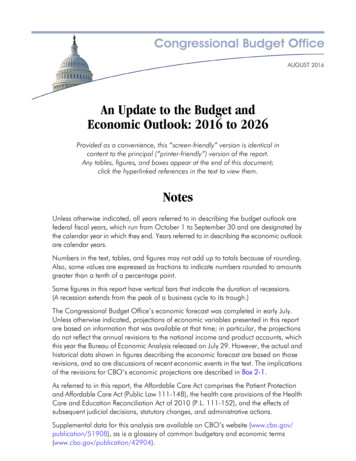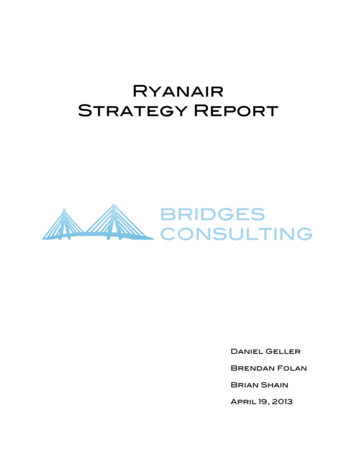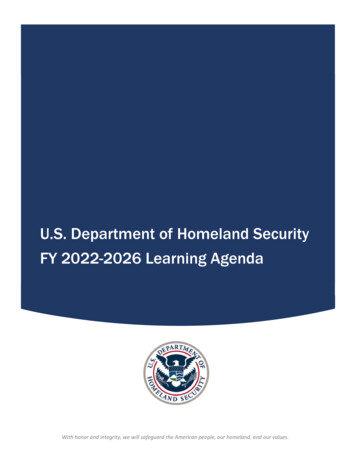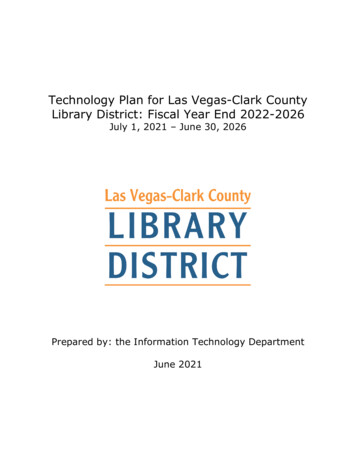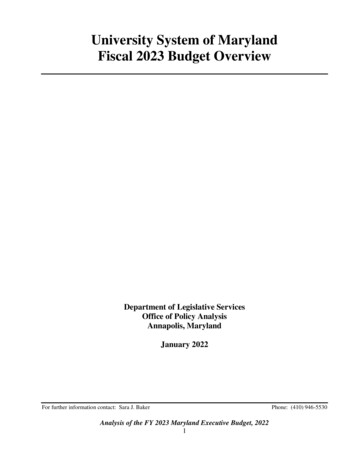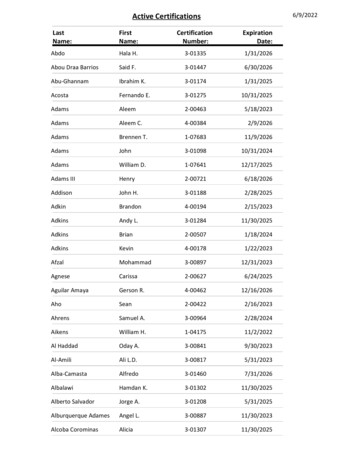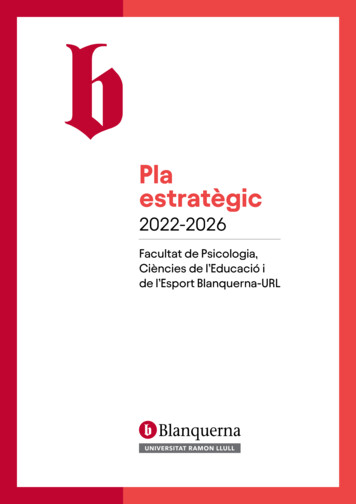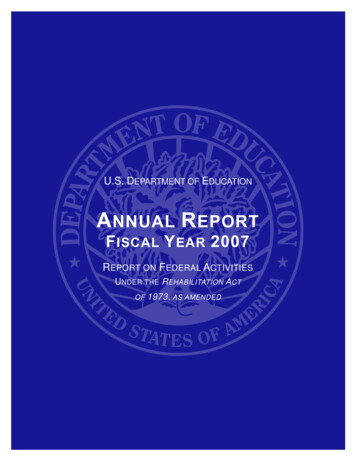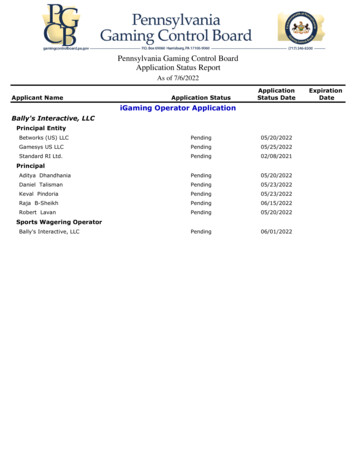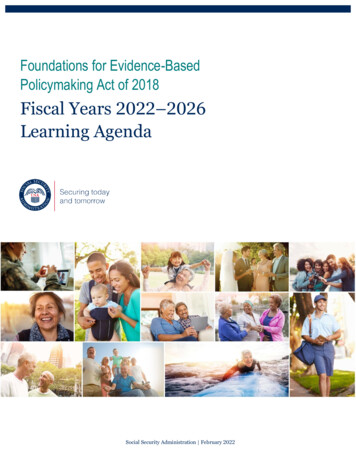
Transcription
Foundations for Evidence-BasedPolicymaking Act of 2018Fiscal Years 2022–2026Learning AgendaSocial Security Administration February 2022
ContentsIntroduction .3List of Priority Questions . 5Supporting Information on Priority Questions . 6Supporting Effective and Equitable Delivery of Social Security Services.6Assessment of the Disability Programs .9Assessment of the Public’s Preferences and Needs for Online Services . 12Assessment of Customer Communications . 14Evaluation of the Redesigned Social Security Statement. 16Assessment of the Public’s Knowledge of the Disability Programs and How that Knowledge Affectsthe Decision To Pursue Disability Benefits . 18Assessment of Employment Barriers and Mitigation Efforts . 19Analysis of Federal Court Remands . 22Analysis of Program Simplification Proposals . 23Development and Evaluation of Interagency Collaborations . 25Appendix A: Request for Information . 28Comments from Individuals . 28Comments from Organizations . 29Selected AbbreviationsASPDIFYOASIOMBSSASSABSSIAgency Strategic PlanDisability InsuranceFiscal YearOld-Age and Survivors InsuranceOffice of Management and BudgetSocial Security AdministrationSocial Security Advisory BoardSupplemental Security Income
I NTRODUCTIONThis Fiscal Years (FY) 2022–2026 Learning Agenda describes our evidence-building roadmap tosupport the goals in our FYs 2022–2026 Agency Strategic Plan (ASP). We identified ten priorityquestions that correspond to the ASP goals. The priority questions include short-term and long-termquestions related to our mission, strategic plans, and agency operations. We expect that answers toour priority questions will provide valuable information about our agency’s performance and promoteevidence-based decision-making.We gathered information from internal and external stakeholders to develop our Learning Agenda. InJanuary 2021, our Evaluation Officer held an initial meeting with internal stakeholders from all ourmajor offices. At the meeting, our Evaluation Officer provided a description of the Learning Agenda, adescription of possible Learning Agenda questions, and a sample of information we would includewith a priority question in the Learning Agenda. Our Evaluation Officer established a working groupwith two representatives from each of our 11 major offices to obtain their input as internalstakeholders and to identify priority questions.The working group sought input from external stakeholders that included members of the public,agencies, State and local governments, and representatives of non-governmental researchorganizations. To solicit input specifically for our Learning Agenda, on April 20, 2021, we published inthe Federal Register: Request for Information on the Foundations for Evidence-Based PolicymakingAct of 2018 Learning Agenda. To encourage comments on the Request for Information (RFI), weworked with our Office of Communications to send a “Dear Colleague” letter to 3,000 externalstakeholders and we publicized the RFI on our What’s New web page that reaches 59,000 subscribers.We considered all comments including those that recommended research or improvements to ourprograms in several areas: Understandability of our communications; Data sharing and collaboration with other agencies; Collecting race and ethnicity data; Timely and equitable service delivery; Work incentives; and The Ticket to Work program.We regularly receive information on potential research and evaluation activities during routinecommunications with advocacy groups, our State and Federal agency partners, and the Social SecurityAdvisory Board (SSAB). For example, our Associate Commissioner for the Office of Research,Evaluation, and Statistics sends an annual request for research topics to the SSAB. We consideredtheir response to the request as we developed our Learning Agenda. We also obtained informationfrom the SSAB’s Roundtable on Social Security's Public Service that included a discussion ofunderserved populations and relevant research questions that we considered for inclusion in ourLearning Agenda. The working group used this information as part of the process of developing andrefining priority questions. Stakeholders expressed interest in further research and improvements toour programs to address the decline in disability applications during the COVID-19 pandemic or due toother long-term trends, race and ethnicity data, challenges related to providing in-person servicesneeded by certain populations, improving service delivery for people facing barriers, and improving ourcommunication and outreach.Social Security AdministrationFYs 2022–2026 Learning Agenda3
The working group compiled a list of potential priority questions based on the information gathered frominternal and external stakeholders and completed a process of refining and prioritizing the questions. Indeveloping the final list, the working group focused on identifying a mix of short-term and longer-termpriority questions that would inform goals in the FYs 2022–2026 ASP. After consulting with agencyexecutives, we arrived at the ten priority questions identified in this Learning Agenda.For each priority question, we provide background information and the actions we will take to answerthe question. Specifically, we include: A project title; The corresponding agency strategic goal and objective; A description of the rationale and activities for the priority question; The timeframe for addressing the priority question; The potential data, tools, methods, and analytical approaches; The anticipated challenges to addressing the priority question; and The proposed solutions to those challenges.Social Security AdministrationFYs 2022–2026 Learning Agenda4
L IST OF P RIORITY Q UESTIONSPage❶ What are the effects of changes to our service delivery methods on the accessibility, use,efficiency, security, and equitable delivery of our services? . 6❷ To what extent are the Disability Insurance (DI) and Supplemental Security Income (SSI)programs equitably serving and meeting the needs, including return-to-work efforts, of thepopulation that Congress intended these programs to serve? . . 9❸ What are the key factors that influence the public's use of our online services, including theservices we deliver through my Social Security, and what are the effects of methods tomodify these key factors on our customers’ decisions to create my Social Securityaccounts and use our online services? . 12❹ What are the effects of changes to our communication methods on customer satisfaction,program integrity, and administrative efficiency? . 14❺ Does redesigning the Social Security Statement and providing supplemental fact sheetswith customized information on Social Security’s programs improve people’s knowledgeof the programs and increase the use of internet services? . 16❻ Does the working-age population have accurate knowledge of the Social Security disabilityprograms, and to what extent does the working-age population’s knowledge, attitudes, andperceptions of the Social Security disability programs influence the decision to pursuebenefits? . 18❼ To what extent are there systemic barriers to hiring, developing, and advancing a diverseand talented workforce and what are the effects of our Action Plan to mitigate those barriersin support of our goal to build an inclusive, engaged, and empowered workforce? . 19❽ What factors contribute to Federal court remands of disability decisions, and what are theeffects of modifying relevant factors on the percentage of final decisions that are affirmedupon judicial review? . 22❾ What are the effects of simplifying administrative rules and requirements on reducingthe burden on program participants and supporting program integrity? . 23❿ What are the effects of improving collaboration and enhancing data sharing withexternal agencies on saving citizens time from reporting required information, reducinglabor market barriers, improving program solvency projections, improving programadministration, and reducing improper payments? . 25Social Security AdministrationFYs 2022–2026 Learning Agenda5
S UPPORTING I NFORMATION ON P RIORITY Q UESTIONS❶ PRIORITY QUESTIONWhat are the effects of changes to our service delivery methods on the accessibility, use,efficiency, security, and equitable delivery of our services?Project Title: Supporting Effective and Equitable Delivery of SocialSecurity ServicesFYs 2022–2026 ASP Goal & Objective: Optimize the Experience of SSA Customers Identify andAddress Barriers to Accessing ServicesDescription: Our customers traditionally had several options for conducting business with us includingthe use of in-person and telephone service at our field offices, telephone service using our National 800number, online services including my Social Security, and video service delivery. This priorityquestion will examine the effects of changes to our service delivery methods. It will also supportevidence-building activities relevant to our Equity Action Plan, and Executive Order 14058 onTransforming Federal Customer Experience and Service Delivery to Rebuild Trust in Government.Prior research shows that the field office closures that occurred between 2000 and 2014 resulted infewer disability applications and fewer people receiving benefits, and disproportionately affected thoseindividuals with lower education levels and lower pre-disability earnings (Deshpande and Li, 2019).Specifically, field office closings reduced “the number of disability applications by 10 percent and thenumber of recipients by 16 percent in neighborhoods whose nearest office closes, and have smaller butsizable effects in neighborhoods around neighboring offices.” (Deshpande and Li, 2019, p. 245–246).The decline in applications was twice as large for the SSI program (14 percent for adults and15 percent for children) as it was for the DI program (7 percent). Two of the conclusions that theauthors draw from their study are: (1) the services provided by field offices were instrumental for 10percent of applicants in the decision to apply, and in the past, legal representatives have not filled thegaps created by office closings; and (2) future decisions about field office placement should considerthe distributional consequences of closings. It is important to note that this study estimates the effect ofclosing a subset of offices while other offices remain open and does not speak directly to the effect ofclosing all field offices at once.The public health measures taken due to the COVID-19 pandemic limited the in-person servicesdelivered in our field offices. The data show that applications for DI benefits, SSI aged payments, andSSI disability payments abruptly fell beginning in March 2020. As of December 2021, applications forDI benefits and SSI disability payments have not returned to their pre-pandemic levels. Building onprior research on the effects of field office closings, we will examine the distributional consequences ofthe limited in-person services delivered in our field offices by geographic location, race and ethnicity,demographic, and socioeconomic characteristics. Our findings will provide evidence on thecharacteristics of people who face barriers in accessing our services and will inform our efforts todeliver more effective and equitable services.Our Equity Action Plan identifies our efforts to assist people who face challenges accessing and usingour services. For example, we have taken actions such as providing outreach and support for filingapplications. We established new liaison positions in our field offices to ensure that we provide qualityand compassionate service to people experiencing physical or language barriers, medical conditions, orSocial Security AdministrationFYs 2022–2026 Learning Agenda6
inadequate access to the internet. Our liaisons also communicate with partners, as discussed below,on a regular basis to provide support and guidance on SSI claims. We will evaluate such efforts toestimate the effect on the use, efficiency, security, and equitable delivery of our services. We will usethe results of our evaluation to determine whether we need to use other methods.In the past, we worked with outside organizations through the Substance Abuse and Mental HealthServices Administration (SAMSA)-funded SSI/DI Outreach, Access, and Recovery (SOAR) program toassist people who are homeless. It might be possible to adapt the SOAR model to assist otherpopulations who experience barriers to applying for disability benefits. We will assess whether we cansuccessfully adapt other evidence-based programs that help people access needed services and seekopportunities to form partnerships with other agencies that will enable people to obtain needed benefits.We may initially develop pilot projects designed to assess the efficacy of such programs for ourpurposes before proceeding to a larger scale project that would assess the effects on the use,efficiency, security, and equitable delivery of services.The five agency-specific commitments in Executive Order 14058 on Transforming Federal CustomerExperience and Service Delivery to Rebuild Trust in Government will help us assess new servicedelivery options to improve access to our services. This includes an assessment of services requiringphysical documentation or in-person appearance; developing a mobile-accessible, online process fordocument uploads; maintaining a public policy of technology neutrality in electronic signatures,consistent with applicable law and to the extent practicable; eliminating physical signaturerequirements, consistent with applicable law and to the extent practicable; and supporting customers tohelp identify other benefits for which they may be eligible and integrating agency data and processeswith other Federal and State entitles whenever possible. As we develop and work toward thesecommitments, we will assess the new service delivery methods and identify enhancements that mayimprove the customer experience. We will establish customer research studies and obtain customerfeedback as part of the Executive Order implementation. Although the details are not formalized at thispoint, we will continue to mature the Executive Order roadmaps and deployment plans. In addition, wehave explored the use of a video-conferencing platform using the Microsoft Teams application tocomplete Social Security number replacement card transactions and to participate in hearings beforean administrative law judge. We will continue to assess the use of video-conferencing platforms anduse the results of our assessments to identify potential improvements. We will conduct foundationalfact-finding research to identify other innovative methods for delivering our services.Timeframe: FYs 2022–2026Potential Data, Tools, Methods, and Analytical Approaches: We will use Social SecurityAdministration (SSA) program data to produce descriptive statistics on the characteristics of applicantsand recipients for each of the following programs: (1) Old-Age and Survivors Insurance (OASI) benefits,(2) DI benefits, (3) SSI payments based on disability, and (4) SSI payments based on age. Thecharacteristics will include geographic location, limited English proficiency, pre-application earnings,and other available socioeconomic and demographic characteristics. We will produce descriptivestatistics for three discrete periods: (1) pre-COVID-19 pandemic, (2) during the COVID-19 pandemicwhen in-person services were limited, and (3) when we increase our in-person services to the public. Ifavailable, we will expand this analysis using additional data on race and ethnicity, education level,household income, and other relevant data that is available in the American Community Survey (ACS)that is linked to our program data. This data analysis will provide an initial picture of whether certainsub-populations (e.g., low-income households) experienced larger than average declines inapplications and benefit receipt when we limited in-person services. We will use appropriatemultivariate statistical models to further assess the consequences of changes to our in-person services.This information will help us identify the characteristics of people facing barriers to our service deliverySocial Security AdministrationFYs 2022–2026 Learning Agenda7
methods. The information is foundational for developing effective and efficient outreach efforts, and foridentifying communities where additional assistance is needed when our in-person services are limited.We will use SSA program data to assess the effect of our outreach efforts during the COVID-19pandemic period on applications for benefits, receipt of benefits, the time to a final decision on anapplication (efficiency), fraudulent claims (security), and characteristics of those we serve through ouroutreach (equity). Our assessment will rely on non-experimental methods (e.g., interrupted time series)to estimate the effects of our outreach on these outcomes. We plan to use focus groups, analysis ofour customer experience data, and qualitative studies to supplement our assessment and provideadditional context on the effects of our outreach.We will seek research proposals from the Retirement and Disability Research Consortium (RDRC)centers via the “Improving Service Delivery” focal area to evaluate changes in our service deliverymethods on key outcomes, including those identified in our priority question. We currently fund theRDRC centers at Boston College, the National Bureau of Economic Research, the University ofMichigan, and the University of Wisconsin at Madison. The RDRC centers have expertise using a widearray of data sources, tools, methods, and analytical approaches to conduct their research. Theresearch by Deshpande and Li (2019) is a good example of research funded through the RDRC.For assessments and evaluations of new service delivery methods, we will develop an evaluation planprior to implementation that describes the data, tools, methods, and analytical approaches. We willestablish an enterprise Voice of the Customer feedback collection tool that will allow us to capture realtime customer feedback across all service channels to identify pain points along customer journeys.This will enable us to quantify baseline satisfaction with our various service delivery methods. We willanalyze customer feedback to identify barriers to using our online services and determine ways toimprove or expand our online services and increase customers’ willingness to conduct business with usonline. Our Evaluation Officer will review and approve the plans before implementation of the newprogram.Anticipated Challenges: We have recently completed the agreement with the Census Bureau to linkour program data to the ACS data for statistical purposes, and we will need to obtain approval from theCensus Bureau to use the data for this project. The ACS data is a sample and the microdata for 2020might not be useable due to issues with data collection during the pandemic.Proposed Solutions: We will continue to work with the Census Bureau to obtain needed approval touse the data for this project. We will use the ACS to the extent possible for the analysis, and computeappropriate standard errors to account for sampling error. We will clearly describe the limitation withthe ACS data in 2020 and the methods we used to address the limitation. We will identify our resourceneeds and make a concerted effort to obtain the necessary resources to conduct evaluations of newservice delivery models. We will consult internal stakeholders before we assess service deliverymethods to ensure that we are complying with legal requirements.REFERENCEDeshpande, Manasi, and Yue Li. 2019. “Who Is Screened Out? Application Costs and the Targeting of Disability Programs,”American Economic Journal: Economic Policy 11(4):213–48.Social Security AdministrationFYs 2022–2026 Learning Agenda8
❷ PRIORITY QUESTIONTo what extent are the Disability Insurance (DI) and Supplemental Security Income (SSI)programs equitably serving and meeting the needs, including return-to-work efforts, of thepopulation that Congress intended these programs to serve?Project Title: Assessment of the Disability ProgramsFYs 2022–2026 ASP Goal & Objective: Optimize the Experience of SSA Customers Identify andAddress Barriers to Accessing ServicesDescription: The DI program provides income support, as well as Medicare coverage after a24-month waiting period in most cases, to insured people who meet the definition of disability specifiedin the Social Security Act. The SSI program is a means-tested program that provides incomeassistance and access to Medicaid to adults and children who meet the definition of disability specifiedin the Social Security Act, and to those ages 65 or older. The DI and SSI programs provide access toemployment supports through the Ticket to Work program, and employment and benefits counselingservices through work incentive planning and assistance grants. The programs include provisionsdesigned to encourage work among program participants.While national in scope, there are distinct regional differences in participation in DI and SSI, as well asdifferences in participation by race, ethnicity, sex, age, and socioeconomic background. There mightbe differences in how claims are adjudicated and how people exit from the program (due to both workand medical improvement) that are associated with race, ethnicity, sex, age, and socioeconomicbackground. In support of our Equity Action Plan and Strategic Objective 1.1—Identify and AddressBarriers to Accessing Services, this priority question will address the extent to which these differencesmay be due to the design and administration of the programs and the extent to which they may be dueto external factors. External factors may include systemic barriers in the labor market, access toassistance with the application process, or other local conditions. The question will address whetherthe existing work incentives and services for people with disabilities provide the necessary support forachieving work goals including post-program employment outcomes.Finally, this question will address the extent to which the disability programs are meeting the needs ofbeneficiaries. Studies have found that the DI and SSI programs substantially reduce poverty amongbeneficiaries; however, many continue to have unmet healthcare needs and disability-relatedexpenses, and face barriers to achieving economic mobility. Understanding whether there aredifferences in how the programs meet their fundamental purposes by demographic and socioeconomiccharacteristics, and whether changes are necessary, will help ensure that we administer the programsequitably and that any changes we make to the programs are effective and efficient in achievingintended outcomes. Additionally, as part of our commitment to Executive Order 14058 on TransformingFederal Customer Experience and Service Delivery to Rebuild Trust in Government, we will ensurecross-program benefit eligibility by maximally supporting applicants and beneficiaries to identify otherbenefits for which they may be eligible and integrate agency data and processes with other Federal andState entities whenever possible. This effort will help remove structural barriers to other benefits whilewe address the extent to which the DI and SSI programs are meeting the needs of the public.Timeframe: FYs 2022–2025Potential Data, Tools, Methods, and Analytical Approaches: We will conduct foundational factfinding and interventional research to determine the needs of beneficiaries and whether the DI and SSIprograms are meeting those needs.Social Security AdministrationFYs 2022–2026 Learning Agenda9
The new Disability Research Surveys project will include a detailed survey of new applicants so that wecan learn about how the applicants decided to apply for DI and SSI, their use of representation duringthe application process, and early experiences with the programs. As noted in our Equity Action Plan,this foundational fact-finding research will collect race and ethnicity information for program applicantsand beneficiaries that will help us assess disparities in the application process and the programs, andwill identify potential changes that might be necessary to more effectively serve applicants andbeneficiaries.The new Interventional Cooperative Agreement Program (ICAP) allows us to work with interested thirdparties to test new strategies for supporting people with disabilities. The ICAP announcement identifiedthe following areas of inquiry: Examining the structural barriers in the labor market, including for racial, ethnic, or otherunderserved communities, including people with disabilities, that increase the likelihood of peoplereceiving or applying for DI or SSI benefits; Promoting self-sufficiency by helping people enter, stay in, or return to the labor force, includingtransition-age youth; Coordinating planning between private and public human services agencies to improve theadministration and effectiveness of the DI, SSI, and related programs; Assisting claimants in underserved communities apply for or appeal determinations or decisions onclaims for DI and SSI benefits; and Conducting outreach to children with disabilities who are potentially eligible to receive SSI andconducting outreach to their parents and guardians.In FY 2021, we made two awards. One project will conduct a randomized controlled trial to test anemployment intervention for rehabilitation patients who experienced a recent neurotrauma, while theother project will conduct a feasibility study of implementing the SSI/SSDI Outreach, Access, andRecovery (SOAR) model with incarcerated people with serious mental illness. We plan to solicit newproposals on a recurring basis. Grant awardees will recommend specific data and methods that we willuse for the specific project. We will work with the grantees to ensure that the research and evaluationsare consistent with our evaluation policy (see www.ssa.gov/data). The ICAP is an importantcomponent of two focal areas within our Equity Action Plan.We will conduct demonstrations to determine if potential interventions help reduce barriers to theemployment programs or to the labor market. The Retaining Talent After Injury/Illness Network(RETAIN) project and Promoting Work through Early Interventions Project (PWEIP) will help determineif pre-disability program supports can improve worker connection to the labor force. A secondaryobjective of the PWEIP study is to compile data about evidence-based supported employment modelsand build our knowledge stock of effective interventions for people at risk for but not enrolled in DI orSSI. These projects will use survey data, SSA program data, focus groups, and qualitative methods toconduct both formative and summative evaluations. We are currently testing whether directly referringbeneficiaries and applicants to vocational rehabilitation services will improve access to employmentservices in the Ohio Direct Referral Demonstration. We use program data and a randomized controlledtrial design to evaluate the impact of this project on employment outcomes and program participation.Finally, we will begin a new evaluation of the Ticket to Work program to determine what barriers mayexist in using our return-to-work activities and whether the Ticket to Work program meets the needs ofbeneficiaries interested in returning to work. The evaluations will use SSA program data, survey data,Social Security AdministrationFYs 2022–2026 Learning Agenda10
and appropriate methods to assess the effects of the Ticket to Work program on use of employmentservices, employment, and SSI and DI program participation.We are also working with researchers at the University of Chicago and the National Bureau ofEconomic Research to evaluate the effects of providing early information to families of child SSIrecipients about the transition to adulthood on short-ter
Data sharing and collaboration with other agencies; . communication and outreach. Social Security Administration FYs 2022-2026 Learning Agenda 4 . Our Equity Action Plan identifies our efforts to assist people who face challenges accessing and using our services. For example, we have taken actions such as providing outreach and .
